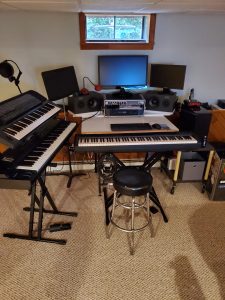This will be the first of many posts about my experience with a learn-as-you-go songwriting project. The project started about thirty-three years ago when I teamed up with a songwriting partner, Kelly Padrick. Over a period of about three years we collaborated on a whole bunch of original songs. Some of them are pretty good, and others are, meh!
Over the last couple of decades I have taken some of those and a few of my own and touched up the lyrics and music where I felt they could be better crafted. One of those songs titled "Who Will Break My Fall", is the project that I started about a month ago in my home studio, and it's the subject of this and the following series of posts where I will be describing the entire process of taking a musical work from start to finish.
My starting point was to record the finished song in my home studio and then bring those tracks into a professional recording studio for the do-overs. Once the recording process was completed, a final mixdown was rendered for mastering.

I will be writing in depth about my experience with copyright, adding metadata and ISRC codes, synchronization licensing, non-fungible tokens (NFTs), streaming and publishing, as they occur. Not to worry, I'm very inexperienced with all these things since my main gig for the last thirty years has been primarily as a performing and work-for-hire artist only. My intention is to learn how to properly monetize a song so that I may be rewarded for the time, work and money that I have invested into this project. Also, I want to share my learning experience with anyone who may benefit from it. I very much appreciate questions and comments, especially from experienced creators, team members and supporters who are willing to offer some advice, criticism and help.
UPDATE: Tuesday, February 15, 2022
Today, the final mixdown of WWBMF was rendered by Mr. Emerson Torrey at Satellite Recording Studio in 24-bit, 48KHz WAV format for mastering. The recording studio and I both have a copy, and I will save another backup copy to a USB drive. The next two things that I need to do are the registration of copyright at the Library Of Congress, and finding a mastering facility for my song and the audio engineer who will master the recording. I will post more about my experience as I go through the process.
For now, I want to back up a little and briefly explain about the process leading up to today. Even before I started to record the music in my home studio, I took some time to edit and finalize the lyrics for WWBMF and decide on the key signature and tempo for the song. It's really a pain in the ass when you get too far into a recording project and realize that the vocals suck because you didn't take the time to find the right key for your vocal range.
The next step was writing out the song arrangement so I would know exactly how many measures were needed for the next step, that is, programming the drum application. EZDrummer is the program that I use to write drum parts for each verse, chorus, bridge and what have you. With the drum track finally programmed, I exported it as a 24-bit, 44.1KHz WAV file to be imported into the recording program. It really wasn't necessary to expend a great deal of time and effort on the drum track since my preference was to add a drummer at a later date.
I'm use Nuendo as my recording software along with PreSonus FireStudio 8-in, 8 out Digital to Analog Converter (DAC).
A new project was opened in Nuendo with the tempo set to 120bpm to match the tempo in the programmed drum track. The EZDrummer WAV file was then imported as a new audio track in Nuendo. I recorded four tracks of myself playing the piano, the acoustic guitar, the electric guitar and singing the vocal parts.
UPDATE: Thursday, February 17th, 2022
WWBMF was successfully registered for copyright protection through the Library of Congress for a fee of $65. It's a good idea to apply for a copyright to prove ownership of your intellectual property should there be unauthorized use.
Next step; prepare for mastering.
